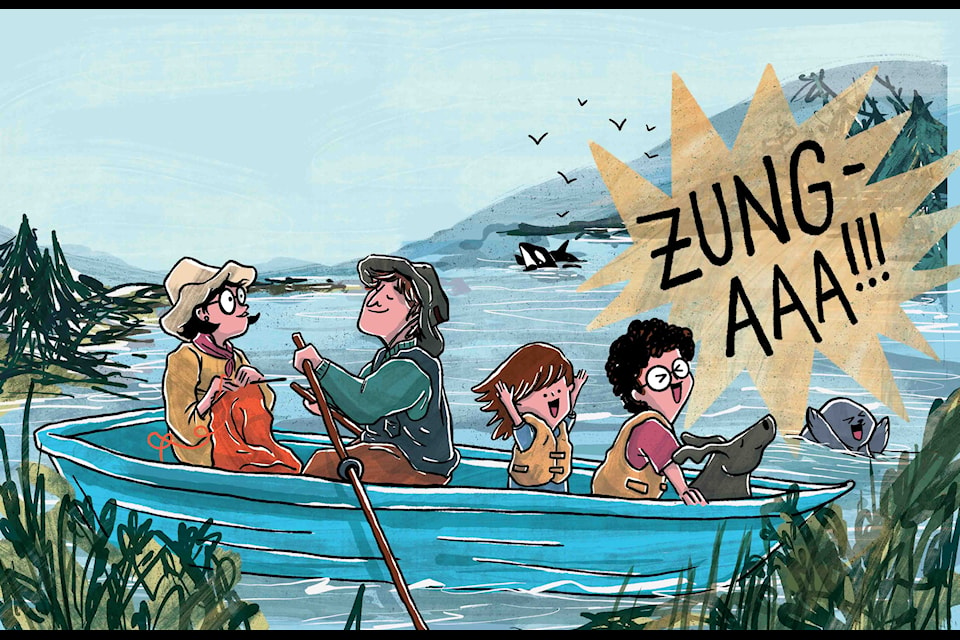Getting carsick in the backseat of your parents' car on the way to the ferry terminal is almost a rite of passage to people living on the west coast of B.C. and Vancouver Island.
It's also something Grant Lawrence describes quite well in his new picture book, "Adventures in Desolation Sound." The book features illustrations by Ginger Ngo, though thankfully most of the illustrations don't feature any bodily fluids. As the title indicates, the book follows the Lawrence family as they have adventures at their cabin located in Desolation Sound.
Lawrence said that while he's been thinking about a few different book ideas for kids, the idea of a kind of kids version of his memoir "Adventures in Solitude: What Not to Wear to a Nude Potluck and Other Stories from Desolation Sound."
"Basically it's the kids picture book version of my first book," Lawrence said. "Because I have kids of my own, the idea came up to do a picture book.
"I had the idea to do a different picture book about another subject, but the publisher suggested doing one around my first book. So we lined up an illustrator and went for it. We're really thrilled with the reception of this one too."
Though the story follows the Lawrence family through one summer, the author said the events were more of an amalgam of a few years on Desolation Sound. Readers of Lawrence's memoir will know that the family spent many of their summers at the cabin, but Lawrence said he wanted to show the beginning of that time in his life.
"It's about our earliest years in Desolation Sound," he said.
Lawrence was interested coming back to this subject matter as a parent. He said that he saw a lot of similarities in parenting between the 1970s and now, particularly around screens. Early in the book, the character Grant and his sister Heather were glued to the TV screen watching re-runs of B��Ԫ������ַ�The Love Boat,B��Ԫ������ַ� when their dad ushers them out of the living room and into the wilderness of Desolation Sound.
"My sister and I were extremely reluctant to go," he said. "One of the takeaways from this book is that a lot of modern parents deal with screen addiction with their kids. One thing I want to get across is that screen addiction is not a new phenomenon. It has existed since the invention of the television. My sister and I were deeply, deeply addicted to ... as back then it was known: the 'idiot box.' "
The book is Lawrence's first foray into the world of picture books. Where in his previous writings, he'd spent years putting together 80,000-word manuscripts full of detail and nuance, he had to find a new way of writing for the shorter format of kids' books.
"In theory, a kid's book does not take that long," he said. "What does take time is the editing. It's also about realizing, as a writer, that when you're writing a picture book, the picture tells a lot of the story. Ginger, the illustrator, was actually a really important element. Obviously, in picture books, it's the pictures that tell a lot of the story, and the words just kind of help drive the narrative.
"When writing this kids' book, I realized you don't have to tell as much as you do in a regular book," he added. "If anything I had to teach myself to write less, and to pull back ... it's a bit of a head trip for someone who's been a writer for a long time."
The other side of the collaboration was done by illustrator Ginger Ngo. The book is full of Ngo's distinctive, fun style of illustrations. Also, as her first picture book, Ngo was excited at the prospect of working on this project with Lawrence, though it wasn't the first project the two had collaborated on.
"I've known Grant for a while now," Ngo said. "I actually built his website for him maybe 10 years ago ... It turns out I also really enjoyed reading his books.
"Fast forward a few years later, and I was sharing some of my drawings online and Grant came across some of them. He just reached out from there and it was an easy answer."
For the most part, Ngo was given a carte blanche to illustrate how she wanted. However, Lawrence had a few requests for certain things to be portrayed accurately.
"I wasn't able to go to Desolation Sound, but I did do a lot of research," Ngo said. "I'm in Vancouver, so I went to Stanley Park to do more of my observational drawing, and I tried my best to match that to both Grant's description of the place."
"I was actually surprised that the process wasn't linear," Ngo said. "I had to pick three or four spreads to do at first, so the story wasn't illustrated from beginning to end ... it was an interesting process for me."
That's the thing about a picture book about a real place: the people who live there or who have been there will notice when something's just not quite right. However, it also inspires the young readers who are the target audience of this book to get out there and see it for themselves. For Lawrence and Ngo, that sounds like a great idea.
However, for parents making the drive, it might be worthwhile taking it easy on the curves.



